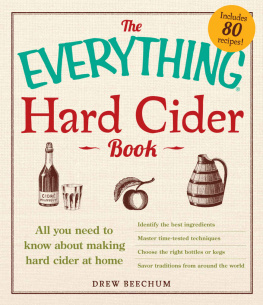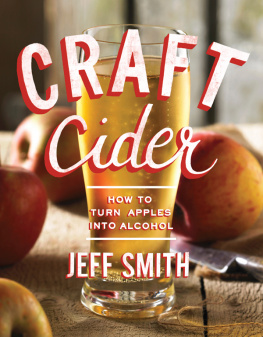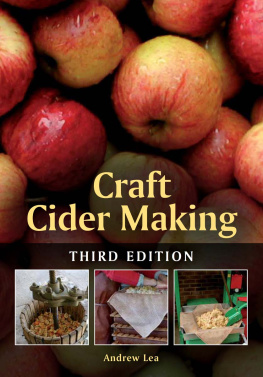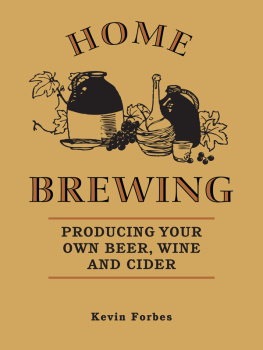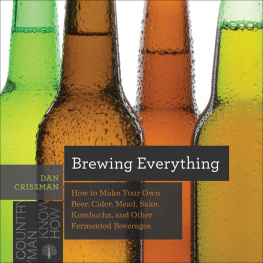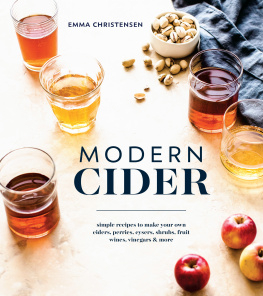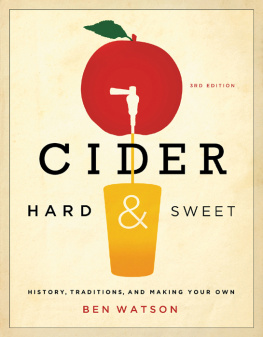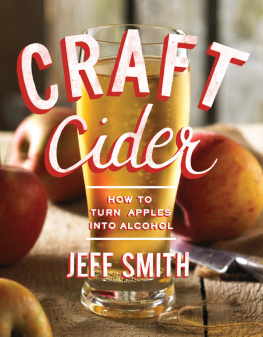Thank you for downloading this Simon & Schuster ebook.
Get a FREE ebook when you join our mailing list. Plus, get updates on new releases, deals, recommended reads, and more from Simon & Schuster. Click below to sign up and see terms and conditions.
CLICK HERE TO SIGN UP
Already a subscriber? Provide your email again so we can register this ebook and send you more of what you like to read. You will continue to receive exclusive offers in your inbox.
THE

HARD CIDER
Book
All you need to know about making
hard cider at home
Drew Beechum

Avon, Massachusetts
Contents
Introduction
CIDER IS A BEVERAGE of long world standing that has sadlyin all but the most purist circlesfallen on hard times. Cider was so central and important that laws dictated that American settlers plant apple orchards. But this once-proud tradition faded in the face of a growing population, industry needs, and a shift of palates to beers produced by and for a new wave of immigrants.
Even in the United Kingdom, traditional homeland of hard core cider drinkers, cider has fallen on hard times. Gone are the complex, flavorful products produced by hand by cidermakers closely connected to the orchard where the apples grow. Instead most things labeled as cider are mass-produced sweet alcoholic sodas with a vague thought of things appley.
Put simply, real cider is a traditional form of fruit wine, albeit one made with apples and/or pears (perry). It can be anywhere from desert-dry to dessert-sweet. The carbonation ranges from nonexistent to gushing, like champagne. It may taste clean and simple or challenge your taste buds with acidity and an intense, ancient, and wild character.
So why cider now? Look at American culture over the past sixty years. The 1950s saw the great blandification of American tastes. Food became an industrialized commodity with a focus on convenience rather than taste. Periodically, little pockets of rebellion would kick up. The 60s and 70s saw the rise of the American wine industry. In the 80s and 90s, the first craft breweries began from the fevered experiments of homebrewers. As the country hit the turn of the millennium, real cooking became cool again.
The new craft beer and food movements gave rise to an revitalization of the local and traditional. Call it locavorism, if you must, but people have discovered the power of knowing where something is made and who made it. With that, cider is finally seeing its long-predicted renewal as a bright member of the American drinks squad. Serious money and talent is beginning to focus on the apple. Old-school craft brewers are eyeing the field and bring products to market. Farmers are happily following right along since they finally have a market that needs decent and odd apples for a good price.
Another compounding reason for ciders growth is the rise in the interest of low-gluten diets. Low- or no-gluten diets are a response to the increased diagnosis of gluten intolerance like celiac disease. Unfortunately for sufferers, gluten is a combination of two very common proteins, gliadin and glutenin. Together they form gluten, a tough webby mesh that gives things like bread its chew.
Sadly, this means beer is out if you are gluten intolerant. Sure you can drink wine, but sometimes you want to relax with something bubbly and low-key like beer. Youll notice that cider is being heavily promoted as gluten-free and why not? Cider tastes awesome while gluten-free beer, despite everyones best efforts, still tastes pretty blah.
No matter the reason you want to explore ciderbe it dietary, historical, or just the want for a different tastetheres a way to enjoy and appreciate the gift of the apple tree. It starts in your home. It requires just a few tools, a few ingredients, and a little patience. Put those together and youre on your way to enjoy a great tradition!
CHAPTER 1
A Cider Primer
Cider played an important part in American history, and in many ways it was the countrys original drink. Unfortunately, the forces of Prohibition and industrialization conspired to reduce cider from its proud, noble perch to a sad, neglected state. But just as wine and beer enjoyed their own revivals, people who are interested in flavor, tradition, and craft are now rescuing cider.
Cider Apples Versus Culinary Apples
As you read about cider, youll notice a fair amount of discussion centering on culinary versus cider apples. What does this mean? Culinary apples are the eating or baking apples that you encounter in your supermarket produce section. Think your everyday Red Delicious, Golden Delicious, Fuji, or Granny Smith apples. These apples, even the tart Granny Smith, all contain a high amount of sugar with a restrained bitterness and acid level.
Cider apples used to be the dominant form of apple. The average orchard focused on these mean little hard globes. If you were to grab a traditional cider apple, like a Winesap or a Cox Pippin, and take a bite, youd be floored by the flood of sharp and bitter flavors.
Instead of a wave of sugary sweetness, the juice is heavily acidic like a Granny Smith. The juice also carries an astringency that, to our modern tastes, rings alarm bells. A good comparison to this level of puckering is the taste of medicine, like aspirin, left on the tongue too long. Ironically, cider apples tend to be as sugar filled, if not more so, than culinary apples; you just cant taste it due to the other sensations.
You may think it strange that for most of history these unpalatable little buggers have been cherished, fostered, and shepherded around the world. The reason should be obvious, given that you are reading a hard cider book! When the juice is extracted and mixed with yeast (naturally occurring or introduced by the cider maker), the previously harsh characters change and begin to meld into a beverage of great character.
Most cider books will now stop and say, Dont make cider with culinary apples. They can only make bland, insipid, boring cider. Use real cider apples! This is sound advice; cider apples do make better cider. The problem for most cider makers is the impracticality of procuring enough true cider apples without growing your own. Thankfully, there are a few tricks that you can use to transform bland culinary apple juice into a great-tasting cider.
CiderMagic Apple Saver
Food spoilage has always been a big problem for humanity. To combat this, mankind developed a number of techniques, including pickling, salting, drying, preserving, and fermenting.
Picture a bag of apples. You store them somewhere cool, maybe your fridge. For a few weeks your apples are just finecrisp, juicy, sweet. But slowly, imperceptively at first, the apples lose their crispness. Softness creeps in. The flesh turns mealy. Then faster, brown bruised spots that taste sickly sweet and just a little funky begin to appear. The apple withers and shrinks, the once-taut skin becoming wrinkly and rubbery.
Today, this is a cause for grumbling and a trip to the store to buy some more apples. Back in the day, it could spell disaster for you and your family. Even in the coolness of a proper root cellar, apples will only last for a few months.

The phrase bottom of the barrel has multiple origin stories attached to it, one of which relates to the notion that the apples at the bottom of the barrel were the least desirable due to age and bruising from the weight of the apples above.

